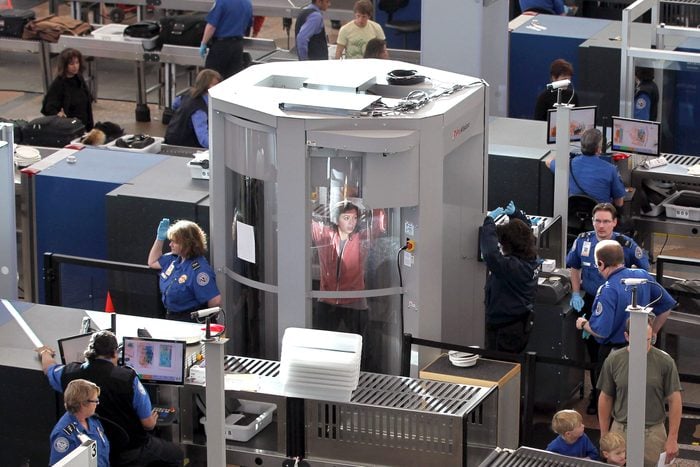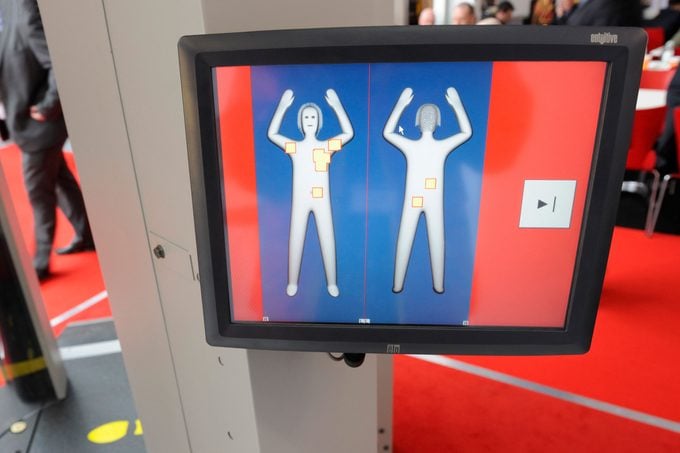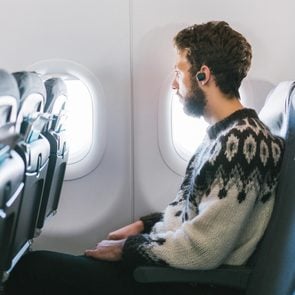What Do Airport Body Scanners Really See?
Updated: Jan. 26, 2023

Sure, airport body scanners are looking for threats, but here’s what else these security devices might reveal in the process
Some of us remember when friends and family could walk you to your gate and you could board an airplane without a detailed airport security check. Now, of course, you have to worry about the TSA carry-on rules—including the liquid limit and food rules—and figure out what to pack in your checked luggage instead. And then there are the metal detectors, facial scanners and body scanners. You know those machines are there for your safety, but they still may give you pause—especially the body scanner. After all, what does it show, exactly? Can TSA agents see you naked?
Those are valid questions. You might also be wondering if body scanners are safe and if you can skip them if you sign up for Global Entry or TSA Pre-Check. We spoke to TSA experts to get the lowdown on airport body scanners so you know exactly what to expect the next time you head to the airport.
How do body scanners work?
Before we answer the question of what body scanners see, we need to discuss how they work. What happens when you step into the machine, place your feet on the footprints and put your arms over your head? “Body scanners use a technology called Advanced Imaging Technology (AIT) for full-body scans at airport checkpoints,” explains TSA spokesperson R. Carter Langston. “It’s a millimeter wave scanner that detects a wide range of metallic and nonmetallic threats in a matter of seconds.”
While there’s a lot of complicated science behind that millimeter wave imaging, here’s the gist: “Essentially, the machines send millimeter waves toward a passenger’s insides,” explains Shawna Malvini Redden, PhD, the author of 101 Pat-Downs and a communication researcher who has studied the TSA since 2010. “The waves go through clothing and reflect off the passenger’s skin (and whatever else is concealed) and bounce back an image, which is interpreted by the machine.”
If the electromagnetic waves hit something that seems suspect, a Transportation Security Officer (TSO) will investigate further. But if not, says Langston, you can pass right through the security checkpoint without a pat-down or other physical contact. Have something you shouldn’t? Here’s what happens to items confiscated by the TSA.
What do body scanners see?
Body scanners are looking for items that could be potential threats; they’re not looking at your physical body. The TSOs see “a generic human form—or avatar—to ensure passenger privacy while maintaining security effectiveness,” Langston says. This looks kind of like a gingerbread man or paper doll.
“With millimeter wave machines that have the privacy software installed, TSOs are only seeing this outline with a green ‘clear’ or a red ‘stop and check’ signal,” Malvini Redden explains. “If someone has something in their pockets, for instance, the machine will put an alarm note in the paper doll’s groin region so the officer knows generally where to search.”
Do airport body scanners see you naked?

According to the TSA, a body scanner doesn’t show your naked body on its screen … anymore. “Early versions of the scanners came out without any privacy protections, and TSOs in the checkpoint could be looking at naked images of passengers as they went through the screening,” explains Malvini Redden. These scanners used backscatter technology, but because of privacy and health concerns, those machines were removed from all airports in 2013. “Now when passengers are scanned, the machines are supposed to generate generic images of a body instead of the passenger’s unique image.”
Millimeter wave machines don’t see nipples or genitalia, and they do not pick up size, weight or height. Can you see a tampon during an airport body scan? This is a frequently asked question on Google, and if it’s something you’re worried about, you can breathe a sigh of relief. Airport body scanners can’t see inside the body and therefore can’t detect a tampon on a TSA female body scan image. “Millimeter wave imaging technology does not detect items inside a passenger’s body or penetrate the skin,” Langston says.
That said, Malvini Redden says body scanners would also not pick up anything else stashed inside a body cavity, such as drugs or hazardous liquids. These items might be detected, however, if they were in your pockets. In case you were wondering, you might have to go through a body scanner again if you’ve left the airport during a layover, but not if you’re simply getting a connecting flight.
What are airport body scanners looking for?
Airport body scanners alert the TSO to threats—mainly weapons such as knives, guns and explosives. They are designed to detect “metallic and nonmetallic threat items,” according to the TSA. Those are things like explosives or knives made out of materials other than metal, like ceramics, says Malvini Redden.
That said, “benign undivested items” may also be picked up by the AIT, which is why it’s worth thinking about what you wear on a plane. What are benign undivested items? Those are the things we’re supposed to put in the bins before walking through security checkpoints but accidentally forget about. Think watches, keys, belts, coins, jewelry, IDs, phones and the like.
What might accidentally set off a body scanner?
Aside from the items you’ve forgotten to put in the bin, there are a few unusual things that can cause a body scanner to come back with that dreaded red signal. The TSA declined to respond to this question, but according to Malvini Redden, the most contentious trigger is thick hair, especially if it’s in a braid or a bun and if there are clips holding it. Other things that accidentally set off body scanners are body piercings and wire supports in undergarments. External tumors might also trigger the machine, but growths inside—such as fibroids—will not.
“Perspiration is probably the weirdest thing that can set off the scanners,” Malvini Redden says. “It has to do with millimeter wave technology and how the waves bounce off water.” She adds that since these machines often generate false alarms like this, some countries (including France and Germany) have banned them.
Do body scanners really work?
According to the TSA, body scanners are effective at spotting weapons. “It is a proven technology, and we are highly confident in its detection capability,” Langston says. “It has been widely accepted as an alternative to the full-body pat-down, which remains the alternative security screening protocol for those who refuse full-body security scanners.”
Malvini Redden notes, however, that they’re not infallible. The machines can malfunction, the alarms can go off without good reason, and they’re cumbersome and expensive. In short, she says, they “work to portray the appearance of taking security seriously,” but she questions just how effectively they actually do that.
Can you refuse to go through a body scanner?
Yes, you can refuse to go through an airport body scanner. Still, you should always be polite about it—the machines are there for your safety—and be mindful of the things you shouldn’t say to a TSO that might get you flagged as a disruptive or unruly passenger. (These things are similar to what you shouldn’t say to a flight attendant, FYI.)
Just be aware, says Malvini Redden, that if you opt out, “a TSO will physically check your body from head to toe, possibly including an intimate check of breasts/groin/buttocks.” You can request a private room for the screening, but they’re typically done near the checkpoint.
While you can sign up for a TSA PreCheck to skip some of the more onerous security processes like taking off your shoes, removing liquids from your carry-on and taking your laptop out of your bag, you’ll still have to go through the body scanner, according to Langston. But, says Malvini Redden, some checkpoints may direct you to the regular metal detector instead.
Are full-body scanners safe?
Between 2009 and 2013, the TSA used Rapiscan backscatter machines, but there were concerns about safety (in addition to privacy and effectiveness). They produced a stream of low-energy X-rays, which people worried could increase radiation exposure.
The newer AIT scanners, however, use millimeter wave imaging, which is a special type of microwave, not an X-ray. In fact, we’re exposed to this type of non-ionizing radiation every day at low levels, according to the CDC. When exposure is too high, a person may experience tissue damage (for example, a sunburn on a tanning bed), but it’s nowhere near as problematic as the ionizing radiation used once upon a time in airport body scanners.
Still, those who fly often may not want to be exposed to this on a daily basis, and that was doubly true when the Rapiscan machines were being used. In 2010, pilot and flight crew unions successfully lobbied to change the requirements to go through advanced imaging and avoid the excess radiation, says Malvini Redden. Flight attendants followed suit in 2012.
Should regular fliers—even frequent fliers—be concerned today? Nope. “Passengers don’t have anything to worry about. The AIT scanners are safe,” Langston says. “And the energy emitted by millimeter wave technology is 10,000 times less than what is permitted by the standard cellphone.”
Sources:
- R. Carter Langston, TSA spokesperson
- Shawna Malvini Redden, PhD, professor and communication researcher and the author of 101 Pat-Downs
- U.S. Immigration and Customs Enforcement: “‘Underwear Bomber’ Umar Farouk Abdulmutallab sentenced to life”
- CNN: “TSA removes body scanners criticized as too revealing”
- How Stuff Works: “How Millimeter Wave Scanners Work”
- ProPublica: “Sweating Bullets: Body Scanners Can See Perspiration as a Potential Weapon”



